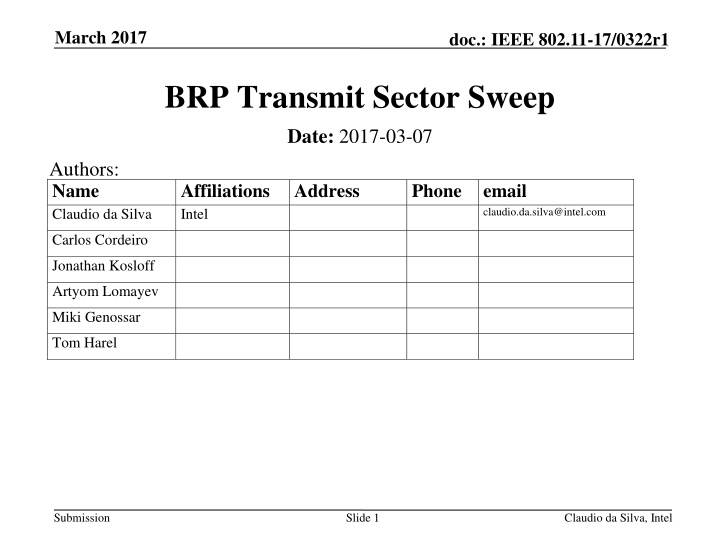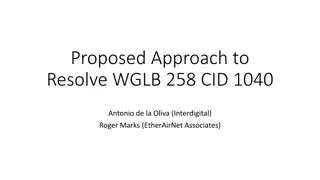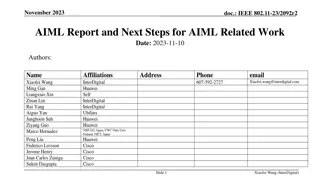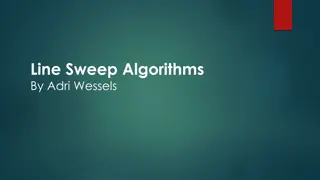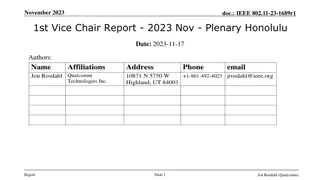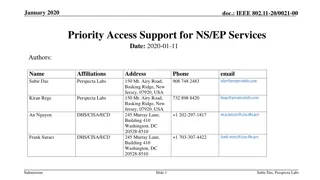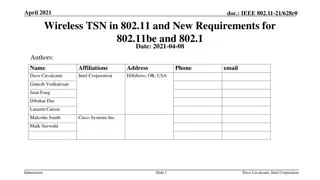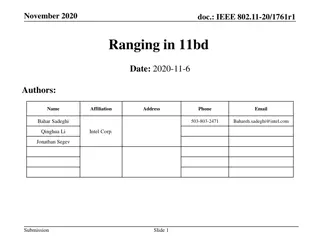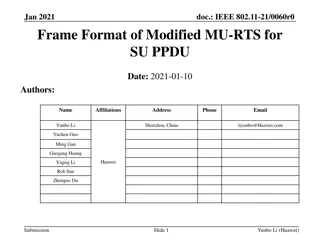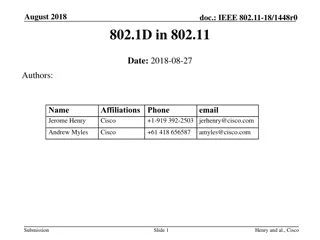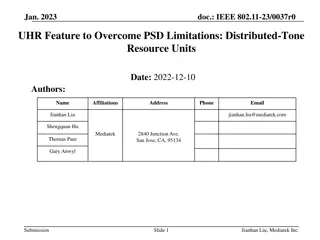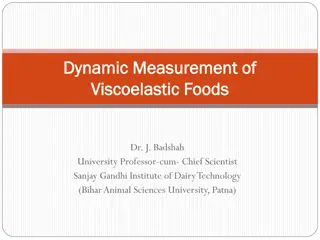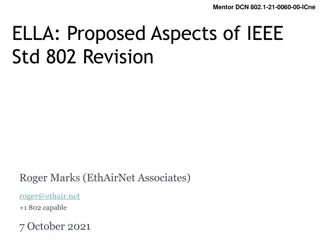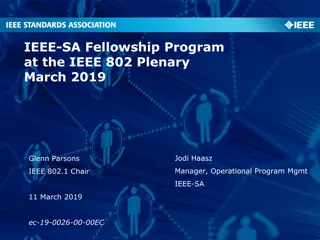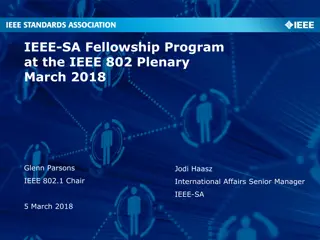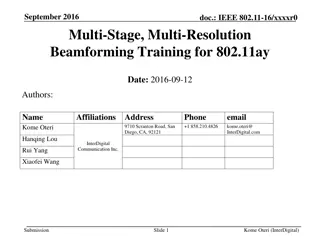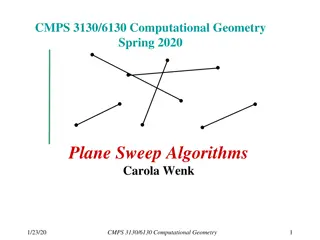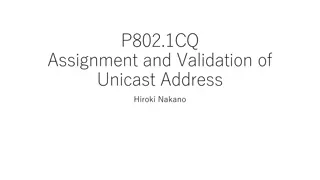IEEE 802.11-17/0322r1 BRP Transmit Sector Sweep Protocol
This presentation introduces a sector sweep protocol for beamforming training using BRP frames in IEEE 802.11-17/0322r1 standard. The protocol aims to enhance the efficiency of transmit sector sweep processes for devices with multiple antennas/subarrays, operating over specified frequency channels. It leverages in-packet training concepts for improved performance.
Download Presentation

Please find below an Image/Link to download the presentation.
The content on the website is provided AS IS for your information and personal use only. It may not be sold, licensed, or shared on other websites without obtaining consent from the author.If you encounter any issues during the download, it is possible that the publisher has removed the file from their server.
You are allowed to download the files provided on this website for personal or commercial use, subject to the condition that they are used lawfully. All files are the property of their respective owners.
The content on the website is provided AS IS for your information and personal use only. It may not be sold, licensed, or shared on other websites without obtaining consent from the author.
E N D
Presentation Transcript
March 2017 doc.: IEEE 802.11-17/0322r1 BRP Transmit Sector Sweep Date: 2017-03-07 Authors: Name Claudio da Silva Affiliations Intel Address Phone email claudio.da.silva@intel.com Carlos Cordeiro Jonathan Kosloff Artyom Lomayev Miki Genossar Tom Harel Submission Slide 1 Claudio da Silva, Intel
March 2017 doc.: IEEE 802.11-17/0322r1 Abstract This presentation describes a sector sweep BF training protocol which uses BRP frames. Submission Slide 2 Claudio da Silva, Intel
March 2017 doc.: IEEE 802.11-17/0322r1 Proposed BF Protocol Features This presentation proposes an efficient sector sweep BF protocol flow with the following key features: It allows very efficient BF flow in terms of time consumption, which is critical for STAs equipped with multiple antennas/subarrays Allows for transmit sector sweep over the bonded channel when the initiator and responder operate on a 4.32 GHz, 6.48 GHz, or 8.64 GHz channel The proposed protocol is based on the BRP concept, i.e. in-packet training, rather than packetized BF Submission Slide 3 Claudio da Silva, Intel
March 2017 doc.: IEEE 802.11-17/0322r1 Proposed flow A BRP TXSS procedure starts with the transmission of a BRP frame which indicates the need for transmit sector sweep by the initiator. After receiving confirmation of the BRP TXSS request from the responder, the initiator transmits EDMG BRP-TX packets to perform transmit sector sweep using each of its DMG antennas, and the process is repeated for each DMG antenna of the receiver. The last packet of a BRP TXSS contains feedback of the corresponding procedure based on measurements performed by the responder during the reception of EDMG BRP-TX packets. Submission Slide 4 Claudio da Silva, Intel
March 2017 doc.: IEEE 802.11-17/0322r1 Proposed flow: Setup An initiator starts a BRP TXSS procedure by sending a BRP frame with the TXSS-REQ field in the EDMG BRP Request element set to 1 and the TXSS-SECTORS field set to indicate the total number of transmit sectors the initiator uses in the BRP TXSS procedure combined over all of its DMG antennas. The FBCK-REQ subfield in the DMG Beam Refinement element carried within the BRP frame shall be set to 10001 (binary) (SNR and Sector ID Order Requested). To confirm the BRP TXSS execution, the responder shall respond with a BRP frame containing a DMG Beam Refinement element with the BRP-TXSS-OK subfield set to 1. Submission Slide 5 Claudio da Silva, Intel
March 2017 doc.: IEEE 802.11-17/0322r1 Proposed flow: Execution The initiator shall then transmit Ninit,TX EDMG BRP-TX packets per each DMG antenna of the responder. The total number of sectors trained in the Ninit,TX EDMG BRP-TX packets sent is N, where N is equal to the value of the subfield TXSS-SECTORS in the EDMG BRP Request element sent in the BRP frame that started the procedure. If the responder has more than one receive DMG antenna, the initiator repeats the transmission of the Ninit,TXEDMG BRP-TX packets for the number of DMG antennas indicated in the last negotiated Number of RX DMG Antennas field transmitted by the responder to the initiator. Submission Slide 6 Claudio da Silva, Intel
March 2017 doc.: IEEE 802.11-17/0322r1 Proposed flow: Feedback The BRP frame with feedback sent by the responder shall have the BRP-TXSS-response subfield within the DMG Beam Refinement element set to 1. The feedback type sent by the responder shall be as requested in the FBCK-REQ subfield in the DMG Beam Refinement element present in the BRP frame that started the procedure. Submission Slide 7 Claudio da Silva, Intel
March 2017 doc.: IEEE 802.11-17/0322r1 PPDU Transmission/Reception All fields except for the TRN field of EDMG BRP-TX packets used in BRP TXSS shall be transmitted with the same DMG antenna and antenna configuration used in the transmission of the BRP frame that started the BRP TXSS procedure. The TRN field of EDMG BRP-TX packets used in BRP TXSS may be transmitted with a different DMG antenna than the one used in the transmission of the remaining fields of the same EDMG BRP-TX packet. All fields of EDMG BRP-TX packets used in BRP TXSS except for the TRN field shall be received with the same DMG antenna and antenna configuration used in the reception of the BRP frame that started the BRP TXSS procedure. The TRN field of EDMG BRP-TX packets used in BRP TXSS may be received with a DMG antenna that is not the same one used in the reception of the remaining fields of the same EDMG BRP-TX packet. The TRN field of EDMG BRP-TX packets used in BRP TXSS may be received with either a quasi-omni receive pattern or a directional antenna pattern. Submission Slide 8 Claudio da Silva, Intel
March 2017 doc.: IEEE 802.11-17/0322r1 Transition Interval The first TRN-Unit in an EDMG BRP packet used in a BRP TXSS may be used for the initiator and responder to switch DMG antennas and shall not be processed by the responder. Therefore, for EDMG BRP-TX packets transmitted during BRP TXSS, the value of the TXVECTOR parameter EDMG_TRN_LEN shall be set to k + 1, where k is the number of TRN-Units used for sector sweep. When transmitting an EDMG BRP-TX packet as part of a BRP TXSS, an EDMG STA may change the DMG antenna used in the transmission of its TRN field during the first TRN-Unit and shall not change DMG antenna during the remaining TNR-Units. When receiving EDMG BRP-TX packets as part of BRP TXSS, an EDMG STA may change the DMG antenna used in the reception of the TRN field during the first TRN- Unit and shall not change DMG antenna during the remaining TNR-Units. Submission Slide 9 Claudio da Silva, Intel
March 2017 doc.: IEEE 802.11-17/0322r1 Feedback Transmission/Reception The BRP packet sent by the responder with feedback of a BRP TXSS shall be transmitted with the same DMG antenna and antenna configuration used in the transmission of the first BRP frame sent by the responder in the BRP TXSS procedure. The BRP packet sent by the responder with feedback of a BRP TXSS shall be received by the initiator with the same DMG antenna and antenna configuration used in the reception of the first BRP frame sent by the responder in the BRP TXSS procedure. Submission Slide 10 Claudio da Silva, Intel
March 2017 doc.: IEEE 802.11-17/0322r1 Reciprocity The subfield TXSS-REQ-RECIPROCAL within the EDMG BRP Request element in the BRP frame sent by the initiator to start the BRP TXSS may only be set to 1 only if: The Antenna Pattern Reciprocity subfield in the DMG STA Capability Information field of the responder and the Antenna Pattern Reciprocity subfield in the DMG STA Capability Information field of the initiator are both equal to 1; and The last BRP TXSS performed between the BRP frame transmitter (that is, the initiator in the current BRP TXSS) and the BRP frame receiver (that is, the responder in the current BRP TXSS) was performed with the BRP frame transmitter in the role of responder and the BRP frame receiver in the role of initiator. Submission Slide 11 Claudio da Silva, Intel
March 2017 doc.: IEEE 802.11-17/0322r1 Reciprocity If the subfield TXSS-REQ-RECIPROCAL within the EDMG BRP Request element in the BRP frame sent by the initiator to start the BRP TXSS is equal to 1, then: The initiator shall only transmit EDMG BRP-TX packets using the DMG antenna corresponding to the best sector identified in the last BRP TXSS procedure between the two STAs and that was initiated by the responder of the current BRP TXSS procedure. The responder shall use a directional antenna pattern when receiving the EDMG BRP-TX packets sent by the initiator. The AWV used by the responder shall be the best sector identified in the last BRP TXSS procedure between the two STAs and that was initiated by the responder of the current BRP TXSS procedure. Submission Slide 12 Claudio da Silva, Intel
March 2017 doc.: IEEE 802.11-17/0322r1 Reciprocity When the subfield TXSS-REQ-RECIPROCAL within the EDMG BRP Request element in the BRP frame sent by the initiator to start the BRP TXSS is set to 0, then: The total number of AWV combinations trained shall be equal to the sum of all sectors employed on all DMG antennas of the initiator multiplied by the number of DMG antennas of the responder. The responder shall use a quasi-omni pattern when receiving the training field of EDMG BRP-TX packets used in the procedure. Submission Slide 13 Claudio da Silva, Intel
March 2017 doc.: IEEE 802.11-17/0322r1 Proposed IFSs Proposed IFSs: Submission Slide 14 Claudio da Silva, Intel
March 2017 doc.: IEEE 802.11-17/0322r1 References Submission Slide 15 Claudio da Silva, Intel
